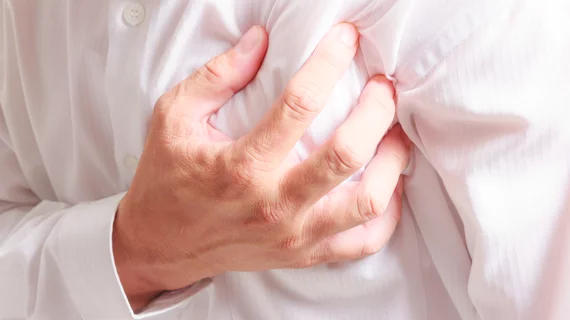The idea of “rapid and complete recovery” in Takotsubo patients is a myth, according to research published in the Nov. 7 edition of the European Heart Journal—and it’s one physicians should be paying more attention to.
Takotsubo—an acute form of left ventricular dysfunction first introduced in 1990 as a neuro-cardiac illness not unlike myocardial infarction—is cardiology’s youngest diagnostic entity, Dana K. Dawson, DM, DPhil, wrote in EHJ. And, while Takotsubo’s infancy means scores of scientists are launching studies related to the disease, it also means today’s “broken heart syndrome” patients are left with little guidance.
“Takotsubo has been widely recognized as a strong, if not the strongest, psychosomatic interaction described in medicine, because the hallmark of this condition is that it is often precipitated by an intense episode of emotional or physical stress,” Dawson, a professor and consultant cardiologist at the University of Aberdeen and Aberdeen Royal Infirmary in the U.K., wrote. “Although acute mortality and morbidity has been recognized, Takotsubo patients demonstrate a natural process of spontaneous recovery.”
That bounce-back rate has been encouraging to cardiologists, Dawson said. So encouraging, in fact, that physicians started to assume Takotsubo was simply a self-limiting condition.
But it’s not, Dawson said, and that became clear as she began to review her own patients at a dedicated heart clinic in 2011. She found that individuals with prior Takotsubo continued to suffer fatigue, breathlessness and limited episodes of chest pain three to four months after their acute event.
Results rolled in from other clinical trials, and they strengthened Dawson’s case. She said one study found Takotsubo patients continued to have some degree of myocardial edema at three months after their event, and, in some cases, edema was still apparent at the four-month mark. Dawson’s lab discovered that patients’ cardiac energetics, which are impaired during a Takotsubo episode, failed to return to normal levels four months after the event. Patients were also experiencing persistent cardiac deformation.
“Despite normalization of left ventricular ejection fraction and volumes, the heart appeared to lose its ability to achieve a full wringing motion that is required for an efficient ejection of the stroke volume,” Dawson said.
Dawson’s team continued their research with the HEROIC study, an observational trial that enrolled 37 patients with prior Takotsubo cardiomyopathy and 37 matched controls. Though they’d experienced their acute events at least one year prior, Dawson said HEROIC participants continued to report symptoms compatible with heart failure.
She said despite normal left ventricular ejection fraction (LVEF) and serum biomarkers, patients with prior Takotsubo had impaired cardiac deformation indices (including reduced apical circumferential strain and global longitudinal strain), increased native T1 mapping volumes and impaired cardiac energetic status.
“HEROIC showed for the first time that Takotsubo cardiomyopathy has long-lasting clinical consequences, including demonstrable symptomatic and functional impairment associated with persistent subclinical cardiac dysfunction,” Dawson wrote. “These findings demonstrated that post-Takotsubo, patients can develop a persistent, long-term heart failure phenotype.”
She said her study yields more questions: What leads to that distinct phenotype? What therapeutic interventions could help, and when should they be introduced?
“Undoubtedly, Takotsubo syndrome is offering an unprecedented opportunity to advance science in a pursuit for therapeutic strategies in a non-ischemic remodeling heart failure phenotype,” Dawson wrote. “Given that this condition is not as rare as previously thought, a better understanding of the mechanisms and the development of therapeutic interventions is urgently required.”

